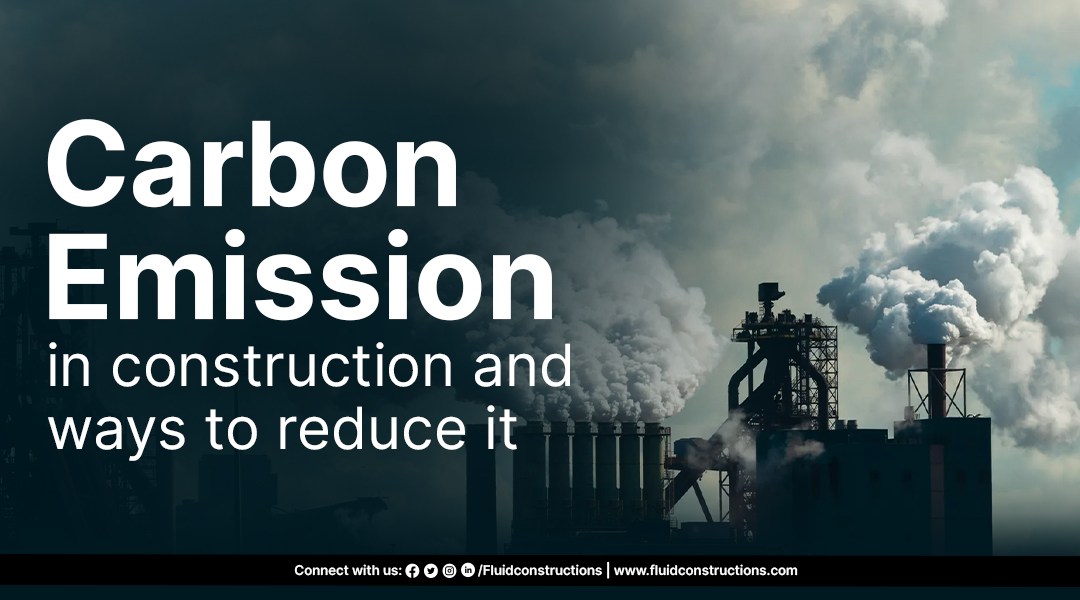
Carbon emission in construction and ways to reduce it
With every passing day, air pollution and global warming are becoming bigger demons that challenge the existence of life on earth. The latest climate summit in Egypt, COP 27, resolved to implement stricter rules against violating anti-pollution measures. Surprisingly at the core of the problem lies the biggest irony! The bulk of environmental pollution comes as the by-product of economic development. Construction, being a symbol of economic development, gets its share of the blame as a major contributor to air pollution.
A new report from the United Nations puts it into perspective – 37 percent of energy-related carbon dioxide emissions came from the construction sector. It further adds that ‘the buildings and construction sector, as a major source of greenhouse gas emissions, must urgently be decarbonized through a triple strategy of reducing energy demand, decarbonizing the power supply and addressing building materials carbon footprint.’
For India, the fastest-growing country that vowed to bring about a meaningful change in the environmental picture, this looks like a very big challenge when it comes to meeting the vast construction needs, yet reducing carbon emissions. Fortunately, experts have identified some key elements in the construction processes responsible for considerable emissions from this sector and suggested the right measures to deal with the situation. Let’s take a brief look at some of them.
Use ESS and smaller diesel generators for a hybrid energy solution
Diesel fuel combustion is a major source of air pollution at construction sites. Diesel-powered machinery like cranes, excavators, generators and heavy-duty vehicles use fuel and emit emissions into the atmosphere. The industry is dependent on diesel fuel because construction sites, particularly those in remote areas, lack grid power.
It is difficult to effectively manage energy usage on construction sites due to varying loads throughout the day. This necessitates the use of a large-capacity generator, which remains underutilized most of the time and causes unnecessary emissions.
The noise produced by the diesel generator sets causes sound pollution in addition to the burning of diesel fuel. This type of pollution is particularly troublesome in cities.
Reducing the need for diesel fuel energy is essential for lowering air pollution during construction. Utilizing Energy Storage Systems (ESS) that use lithium-ion battery technology is one way to achieve this.
Although it is a rare circumstance, sometimes it may be possible to remove diesel equipment from a construction site. Typically, the power required for the site will be provided by a hybrid solution that combines an ESS and smaller diesel generators, allowing it to cut back on fuel use and emissions as a result.
Reduce material waste
Studies emphasize in particular the goals of reducing the use of steel and cement in construction, noting that 32% of all emissions from material consumption are attributed to the minerals in cement and 15% to steel.
However, given the indispensability of steel and cement in modern-day construction, experts emphasize on material efficiency or reduction in material waste during the design phase as one of the most effective ways to reduce greenhouse gas (GHG) emissions by 18% between 2017 and 2050.
Several eco-friendly building materials have become available in construction to lessen this effect. There is no perfect material but many materials, including bamboo, cork and sheep’s wool insulation, can serve as sustainable substitutes.
Switch from conventional cement to low-carbon alternatives
Research says that concrete is one of the most carbon-intensive construction materials as the production of its cement component requires high heat and emits significant amounts of CO2. Therefore, switching from conventional cement to low-carbon alternatives could reduce greenhouse gas emissions by 6% between 2017 and 2050.
The use of low-carbon concrete or green concrete over traditional materials is considered a valid strategy to bring down CO2 emissions. Concrete made from recycled CO2 is seen as a climate change solution and also a win-win from adaptation and mitigation angles. Some examples of eco-friendly alternatives to conventional cement include:
- Ferrock
- Calcinated clay and limestone combination
- Rammed Earth
- Straw Bales
- Timbercrete
- Hempcrete
- Greencrete
Recycle and reuse the building materials and components as much as possible
Studies also highlighted the long-term climate benefits of recycling and reducing building components, such as virgin steel, which could result in a 3% reduction in GHG emissions between 2017 and 2050. This is in line with the recommendation to implement efficiency in material design.
To achieve such an emissions reduction, experts propose a progressive target of an 11% reduction in virgin metal and petrochemical-based materials, though they acknowledge that reusable building materials are unlikely to satisfy the demand for new construction in the near future. However, this objective might be advanced by recycling some structural steel during the construction process.
Use underutilized buildings
Some studies observed that a large number of buildings are underutilized and frequently discarded before they have reached the end of their useful life. This can lead to a level of GHG emissions, which can be avoided. By 2050, strategic use of existing infrastructure and space can reduce GHG emissions by 11% and the need for new construction by 10% to 20%.
Some smart cities are becoming more aware of how to repurpose those buildings for secondary uses as ideas like brick-and-mortar retail fade away and building vacancies increase. Additionally, instead of demolishing existing buildings or destroying forestry to make way for new development, vacant lots can be used for construction and development, which has similar advantages to using existing infrastructure.
Sustainable use of timber in construction
Timber construction is becoming more and more popular as a way to use nearby, sustainably managed forests and cut down on material emissions. Many reports call for a progressive goal of using sustainable timber in the construction of both residential and commercial buildings, which they claim could reduce GHG emissions by 6% between 2017 and 2050.
